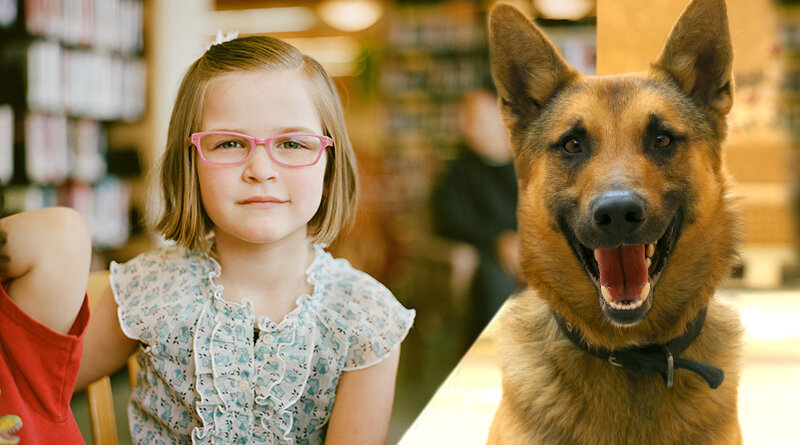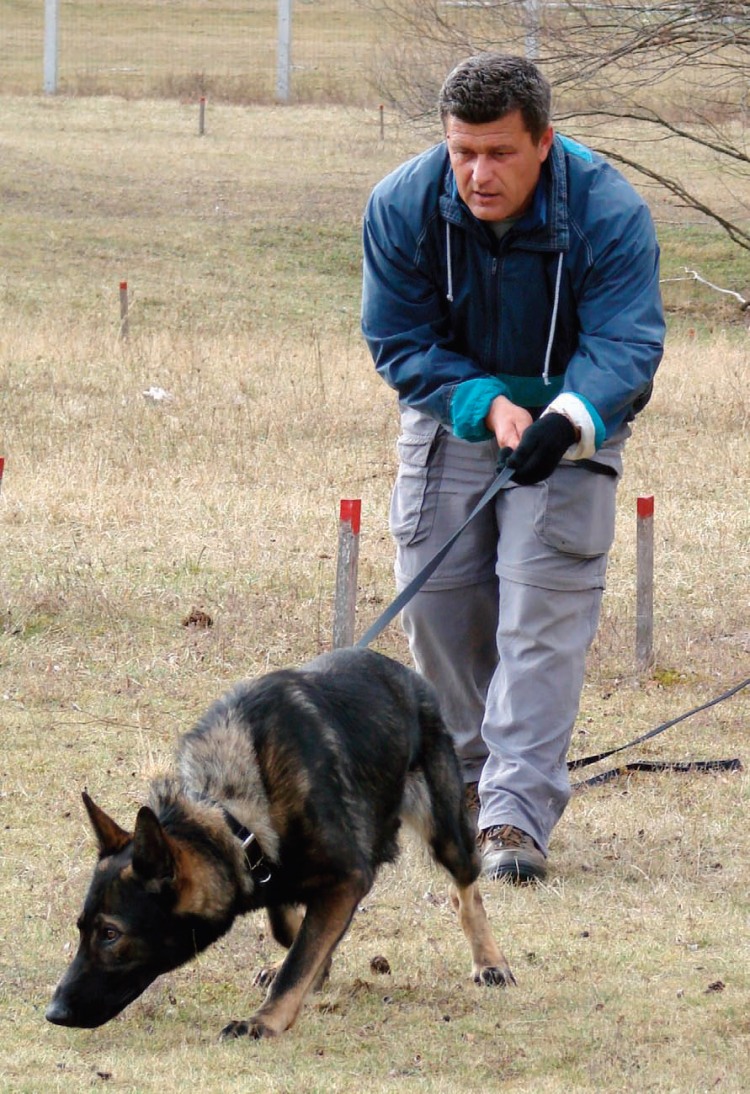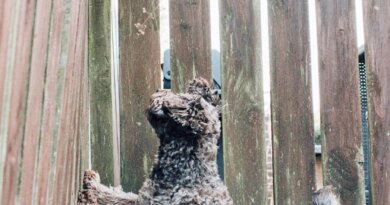Children and Dogs Work Together to Free the World of Landmines
Bianca of Kingston, N. H., is one of those ordinary sixth-graders who loves her dog; in her case, a Bouvier des Flandres named Bear. “He looks like a teddy bear, ” she says. But this 11-year-old girl’s love for her dog—and other dogs and, well, people and the world—motivates her to do some extraordinary things.
Bianca is a student leader in the Children Against Mines Program (CHAMPS), a thirteen-year-old Marshall Legacy Institute (MLI) initiative, in which children sponsor mine-detection dogs. As part of one of the most successful CHAMPS campaigns to date, Bianca can proudly say she’s doing something great for the world. “It’s just amazing—just the little things you do…can help so many people and so many animals,” she says.
It’s safe to say that, in general, children love animals. Why else would so many kids’ movies have four-legged stars, after all? Maybe it’s the unique bond that forms when a child grows up with a family pet. Maybe it’s the way children relate to an animal’s innocence. Maybe it’s just a child’s natural attraction to the cute cuddliness of animals. Whatever the reason this love motivates hundreds of children to make a difference by participating in an effort to rid the world of landmines.
A Deadly Harvest
It’s no secret that war’s effects continue long after the fighting stops, and unexploded landmines are among its more lethal remnants. Either dropped on the ground’s surface or buried just beneath, landmines are meant to disable enemy vehicles and personnel. Unfortunately, cease-fires do not end landmines’ threat —approximately one-third of the world is littered with these deadly devices, making everyday life dangerous for humans and animals alike. “Every 30 minutes, someone is killed or maimed by a landmine,” says Kimberly McCasland, director of CHAMPS. According to McCasland, manual demining teams do what they can, but humans can’t compare to well-trained dogs. People can, of course, find surface mines, but when the mines are buried, the job becomes slow and dangerous. And, since most modern landmines are made of plastic, metal detectors are of limited value. “On a good day, manual de-miners can clear 40 square meters,” says McCasland.
GET THE BARK IN YOUR INBOX!
Sign up for our newsletter and stay in the know.
Luckily, an elite canine force has been trained for the specific purpose of clearing minefields. With extensive training and a trusting handler, a dog can sniff out landmines in a safe manner and save entire communities. On a recent visit to Bosnia, McCasland learned that mine-detection dogs were clearing 1,500 square meters a day. McCasland notes that, in the world of working dogs, “The mine detection dogs are the very highest quality, the very highest tier.” The breed of choice is the Belgian Malinois, which has a winning combination of keen sense of smell, mild temperament and an ability to focus.
When an area is identified as a minefield, a handler and his dog carefully walk the area, creating “safe lanes” between 10-meter squares of land. Once the safe lanes are established and marked, the handler-dog team walks within the lanes, stopping at each 10-meter square. Paying close attention to the handler, the dog moves out of the safe lane into one of the squares, sniffing for explosives.
McCasland notes that mine-detection dogs work under unique conditions. “You see bomb dogs on TV—they’re on a very strong, short lead. Well, these [mine-detecting] dogs have to have the right personality to go out there [ahead of the handler] and, when they find an explosive, to sit perfectly still, point at it and wait until their handlers can identify where they’re pointing. Then the dog is pulled into a safe lane,” she says.
The Penny War
CHAMPS spokesdog Utsi lives with McCasland and helps during presentations, during which McCasland demonstrates the mine-detection work and explains why the dogs are so valuable. Utsi is a graduate of the Global Training Academy in Somerset, Tex. , the only facility in the U. S. that trains mine-detection dogs. Once she completed the course, Utsi worked for five years in Eritrea, Africa, and saved countless lives. Now retired, Utsi tours with McCasland and her daughter, Rachel, who takes care of her.
It costs approximately $20, 000 to adopt and train a mine-detection dog. “They are the cream of the crop, ”says McCasland. Three years ago, when the MLI took on a commitment to raise money for dogs like Utsi and to educate the public about landmines, McCasland was asked to join the effort, and CHAMPS was born.
Diana Enzi, wife of U. S. Senator Mike Enzi (R-Wyo. ), was another early convert to the CHAMPS cause, and due to her involvement, Wyoming was the first state to participate in the program. Enzi speculated that if every K-through-12 student in Wyoming gave 25 cents, they could sponsor a CHAMPS dog. Because animals were involved, the children were inspired, and the response was astounding. Kids not only donated their quarters, but wrote essays, made posters and created the “pooch pouches”in which they collected money.
That is exactly what appealed to Bianca, who first learned of the program when her 4th-grade teacher at D.J. Bakie Elementary School sent home a KIND (Kids in Nature’s Defense) newsletter, published by the National Association for Humane and Environmental Education (a division of the Humane Society of the United States.) On the front page was an article about these incredible mine-sniffing dogs and the CHAMPS program. “I read about it and brought it to my teacher…and asked her if we could do this in class, ” says Bianca. “The whole class got involved, and before we knew it, the whole school got involved. ”
From the beginning, Bianca’s mother, Beth, was enthusiastic about Bianca’s passion. She attributes part of her daughter’s excitement to a child’s natural love of animals. “[The article] was perfect because not only was it a successful story about what the animals can do…but it also broke it down to what kids can do. ”With her mother’s support, Bianca convinced her teacher that they could help sponsor a dog. Once the campaign was launched, it was up to the kids. With a fundraiser called a “penny war, ” Bianca’s school made close to $2,000, mostly in small change. The children, their parents and teachers rolled most of that change themselves. Says Scanlon, “That’s a lot of money when you think about it, $2,000 dollars in change. ”They also had a father-daughter dance and raised both funds and awareness at Kingston Days, a three-day local event. Bianca’s school, together with three other schools in Kingston, raised the $20,000 needed to sponsor a dog—a remarkable feat for a small New England town with a population of just over 5,000.
Kids in Charge
One thing that makes CHAMPS different from other fundraising programs is its level of interactivity. Children have the opportunity to become as involved as they want, and the children themselves run the campaigns. “One of the things the kids learned while trying to achieve their goal is that some fundraisers work out, others don’t, ”says Scanlon. “They’ve done presentations in front of other schools, children, adults. I don’t know about you, but I wasn’t doing that when I was nine!”
Bianca has worked in the program for over two years, and was chosen to attend the CHAMPS gala in Washington, D. C. “It was amazing, ”she says. “We met many ambassadors, four-star generals, senators, [even] Queen Noor of Jordan. ”
Once a group of children decides to embark on a CHAMPS campaign, they can contact McCasland via email or telephone, and she sends out a CHAMPS kit, which includes information and a video about how to launch a campaign. Selected schools are visited by McCasland and CHAMPS spokesdog Utsi. From that point on, it’s up to the children to think of ways to raise money (fundraising tips are provided on the CHAMPS website). CHAMPS kids get to name the dogs they sponsor, and receive frequent updates from McCasland on the dog’s progress. Bianca’s school named its dog Granite, which is also New Hampshire’s state nickname. “He’s also old and strong like granite, so the name fits him very well, ”says Bianca. “He’s a beautiful dog. He looks old and brave. He’s very hardworking, smart. ” Bianca has a lot of affection for the dog her school sponsors. But even with the dangers inherent in Granite’s job, she’s not too worried. “I do worry for them [the dogs], but I know that they are well trained and only two dogs have been killed, and only one trainer. ”
Bianca’s mother is comforted by both the competence of the dogs and their handlers and how much they are doing for the world of animals. “Of course you’re afraid, but they are protected because they are not let out if the wind isn’t correct, the working conditions aren’t correct. ” According to the MLI website, mine-detection teams closely monitor working conditions:“Fatigue, moisture, soil, temperature, wind and many other factors affect the ability of the dog team to work effectively. Work is performed only when proper conditions are met. ”
“It’s tens of thousands of people who are either killed or maimed by landmines, but it’s hundreds of thousands of animals per year. So it is a calculated risk, ” says Scanlon. It is a risk many children are willing to tolerate, especially since, according to the CHAMPS website, approximately one-third of all landmine victims are children. CHAMPS provides a rare opportunity for children to help other children across the world.





